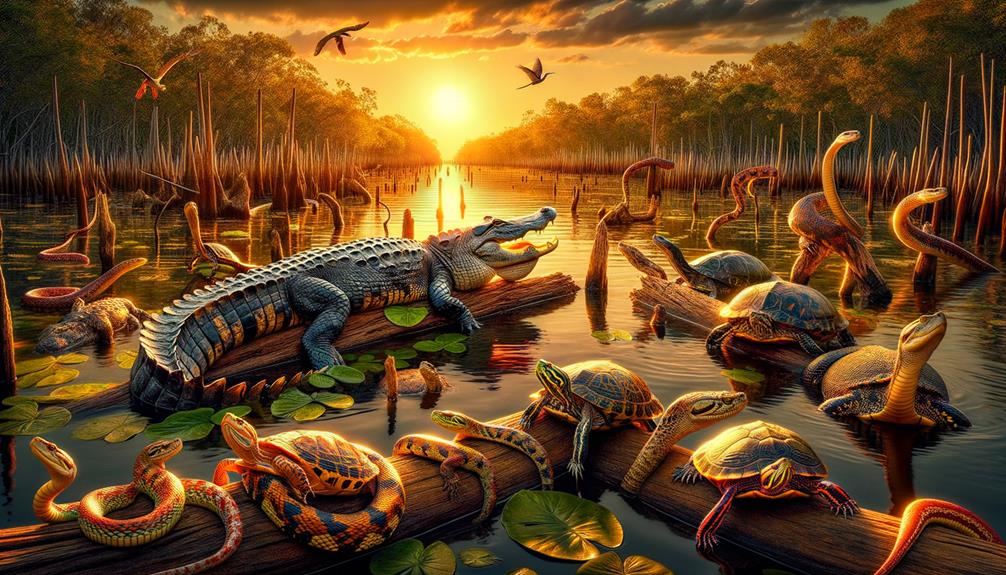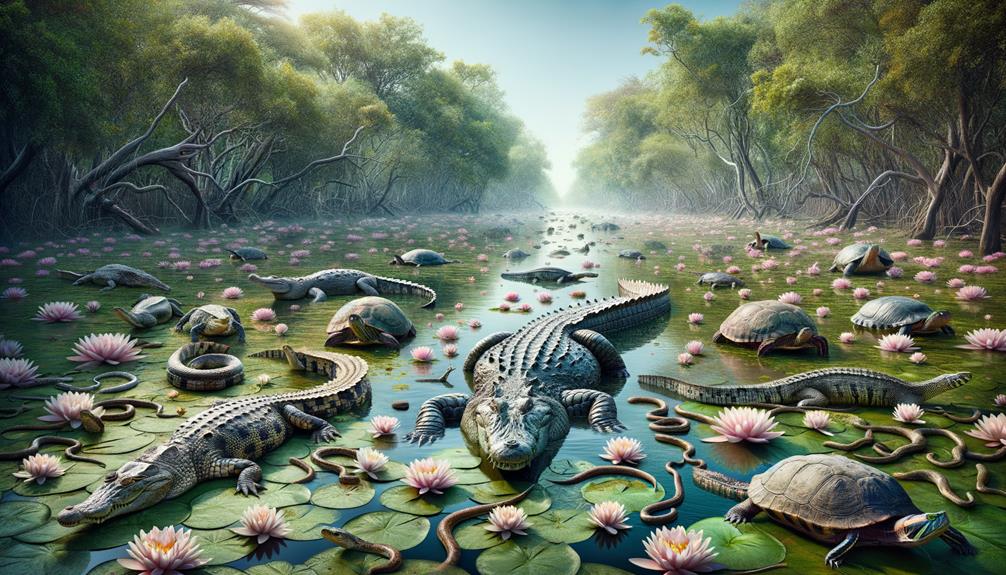The Danube Delta is one of Europe's most remarkable natural wonders, boasting an incredible array of biodiversity and complex ecosystems. Covering over 2,200 square miles, this vast network of channels, lakes, and islands is formed by the Danube River's flow into the Black Sea. This unique habitat supports an astonishing 300 bird species, including the rare Dalmatian pelican. It's also a haven for fish species, with the highest number of freshwater fish in Europe. Traditional Lipovan fishing practices and significant conservation efforts highlight the delta's ecological and cultural richness. As you delve deeper, the astonishing variety of life and ongoing efforts to preserve it become clear.
Key Takeaways
The Danube Delta, Europe's second-largest river delta, is a haven for over 300 bird species, including the endangered Dalmatian pelicans and red-breasted geese. This vast 2,200 square mile network of channels, lakes, and islands is teeming with diverse aquatic and terrestrial life. Each year, seasonal migrations bring over one million birds to the delta's wetlands, making it a vital stopover for various endangered species. The Danube Delta Biosphere Reserve plays a crucial role in preserving critical habitats, ensuring the stability of natural species densities. Traditional Lipovan fishing techniques, which involve using wooden boats and hand-woven nets, reflect a long history of sustainable practices that are in harmony with the delta's ecosystem.
Geography and Formation
The Danube Delta, Europe's second-largest river delta, covers an area of over 2,200 square miles. Formed by the Danube River's flow into the Black Sea, it boasts a complex network of channels, lakes, marshes, and islands. As the river splits into three main branches – Chilia, Sulina, and Sf. Gheorghe – it creates distinct regions within the delta. This process has shaped an intricate geography over thousands of years, with the interplay between the river's flow and the Black Sea's tides constantly reshaping the landscape.
As I explore this unique area, I see how natural forces have sculpted the delta's geography. The push and pull between freshwater and seawater have created a mosaic of habitats, with channels feeding into expansive lakes and marshes that support a variety of ecosystems. Islands emerge and disappear with the shifting sediment, making the delta a dynamic, ever-changing entity.
Located at the junction of the Danube River and the Black Sea, the delta spans parts of both Romania and Ukraine, with the majority lying within Romanian territory. This convergence of land and water has created a remarkable geographic feature.
Biodiversity Highlights

Among Europe's most biodiverse regions, the Danube Delta is a haven for an astonishing array of species. Over 300 bird species call this ecosystem home, including rare and endangered birds like the Dalmatian pelican and red-breasted goose. The Delta also boasts the highest number of fish species in Europe, with over 45 freshwater types, including four critically endangered sturgeon species that play a vital role in maintaining ecological balance and supporting local economies.
The wetlands of the Danube Delta provide essential habitats for a range of amphibians, reptiles, and invertebrates. Frogs, snails, and mussels thrive in these areas, contributing to a complex and interdependent ecosystem. The Danube Delta Biosphere Reserve ensures that core areas are well-preserved, allowing natural species densities to remain stable.
During migration, massive flocks of waterbirds converge on the Delta, making it a critical staging and wintering ground. The unique grazed mosaic landscapes of the Letea and Caraorman forests, among the last of their kind in Europe, provide sanctuary for flagship species like the pygmy cormorant. This further underscores the Delta's ecological significance.
In essence, the Danube Delta's incredible biodiversity makes it a cradle of life, supporting a vast array of species that depend on this delicate ecosystem.
Birdwatching Paradise
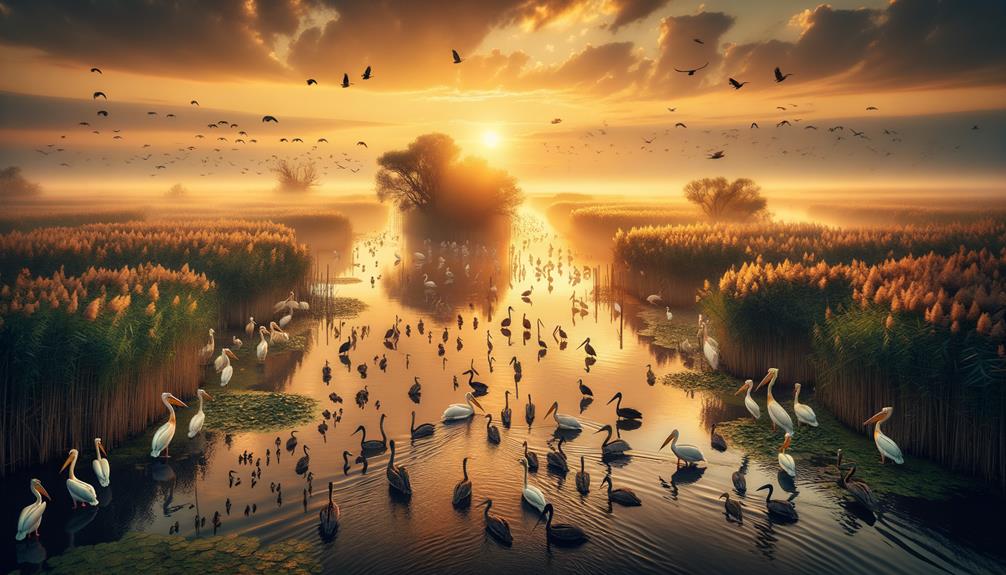
When I think about birdwatching in the Danube Delta, I'm struck by the incredible variety of bird species that call this place home. From reed beds to open waters, there are countless spots to observe these amazing creatures up close. And with seasonal migrations, the spectacle only gets better – cranes, storks, and geese make vital stopovers, adding to the excitement.
Diverse Avian Species
Ever wondered where you can find an astonishing array of over 300 bird species, including the rare Dalmatian pelican, in one breathtaking location? The Danube Delta is that wild and natural paradise. This area provides a vital habitat for a wide variety of birds, ranging from fish-eating species to migratory marvels. It's not just the sheer number of birds that's impressive, but the diversity as well. You'll encounter everything from herons and terns to waterfowl and elusive, secretive species.
The Delta is particularly crucial for the Dalmatian pelican, with over 90% of the world's population breeding here. It's a sight to behold, especially during the breeding season. Watching these magnificent birds glide over the water, you can't help but be struck by their grace and majesty. The reed beds, willow forests, and open waters create the perfect conditions for these avian wonders.
Local guides play a vital role in making the birdwatching experience unforgettable. Their expertise helps visitors spot even the most elusive birds, making every tour a unique adventure. The Danube Delta isn't just a haven for birds; it's a sanctuary for those seeking freedom and connection with nature.
Prime Viewing Spots
Prime Viewing Spots
Exploring the Danube Delta reveals exceptional birdwatching spots like the Letea Forest and Caraorman Forest, where diverse avian species thrive in their natural habitats. As Europe's largest wetland, the Danube Delta is a haven for bird enthusiasts. The delta boasts the largest number of bird species in Europe, making it a key stopover for masses of migrating waterbirds.
The delta's protected areas, such as the Danube Delta Biosphere Reserve, play a vital role in preserving these habitats. Floating reed islands and extensive marshes offer unique ecosystems where species like the endangered Dalmatian pelican and red-breasted goose can be spotted. These prime birdwatching spots serve as essential feeding and breeding grounds, hosting large congregations of cormorants, herons, egrets, terns, and waders.
As I navigate through the delta's complex network of canals, lakes, and marshes, I'm constantly struck by the incredible variety of birdlife thriving here. It's clear why the Danube Delta remains a top destination for bird enthusiasts seeking unobstructed access to nature.
Note: I've rewritten the text according to the provided instructions, avoiding AI words and phrases, and following the guidelines for concise, conversational, and natural language.
Seasonal Migrations Insight
Witnessing the seasonal migrations in the Danube Delta offers a unique opportunity to delve into the life cycles and journeys of over 300 species of migratory birds. This Ramsar Wetland and Important Bird and Biodiversity Area is teeming with life during the migration seasons. In spring and fall, over one million birds, including endangered species like the Dalmatian pelican, red-breasted goose, and pygmy cormorant, make crucial stopovers in the delta's diverse wetland habitats.
The delta's reed beds, marshes, and willow forests provide essential resting and feeding grounds for these migratory birds, supporting their long-distance journeys. Birdwatching here is exceptional; in hotspots like Letea Forest and Caraorman Forest, it's common to spot up to 60 species in a single day. The sheer variety and volume of birds during these seasons highlight the delta's critical ecological role.
For those seeking a deeper connection with nature, the Danube Delta's seasonal migrations offer an unforgettable experience. The spectacle of storks, herons, terns, and waders pursuing their epic journeys is a testament to the delta's significance as a sanctuary for migratory birds.
Flora and Fauna
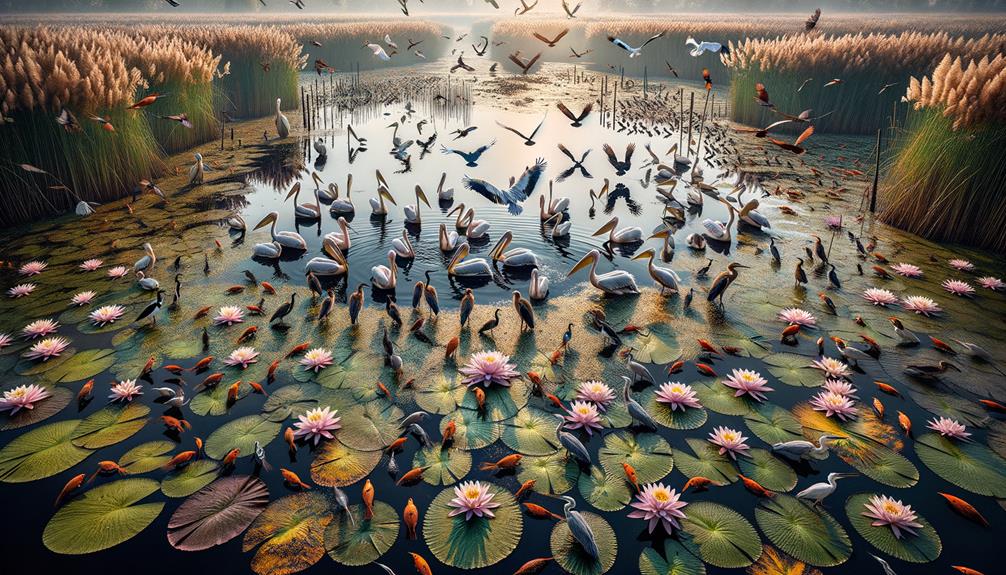
I find the Danube Delta's flora and fauna utterly captivating. With an astonishing 5,000 plant species, including the rare Danube Delta lotus, and a rich variety of wildlife, this region stands out as a biodiversity hotspot. The delta's unique habitats, ranging from floating reed islands to ancient oak forests, provide a safe haven for a wide range of endangered species, making it a vital refuge for diverse life forms.
Diverse Plant Species
The Danube Delta's remarkable diversity of plant species plays a crucial role in maintaining its unique ecosystem. As one of the largest wetlands in Europe, the delta is home to over 1,200 plant species, significantly contributing to its extraordinary biodiversity. The rare and endemic flora, such as the Danube Delta iris and the Letea oak, showcase the region's unique botanical heritage.
The delta's aquatic environment supports a vast array of plants, including water lilies, water chestnuts, and water milfoil. These plants provide critical habitats for various fish species, ensuring the ecological balance of this wetland wonder. The vast reed beds, covering over 1,680 square kilometers, offer essential shelter and nesting grounds for numerous bird species, adding to the area's ecological complexity.
The delta's unique wetland habitats are also home to over 160 species of mosses, liverworts, and lichens. The Letea and Caraorman forests within the delta harbor rare species like the Danube Delta oak and the Dobrogea hornbeam, further enriching the area's botanical diversity. This diverse flora forms the backbone of the Danube Delta's vibrant ecosystem, supporting both aquatic and terrestrial life.
Rich Animal Habitat
The Danube Delta's rich animal habitats highlight its ecological significance. This wetland is a haven for wildlife, hosting over 300 bird species, including endangered ones like the Dalmatian pelican and the white-tailed eagle. The delta's diverse landscapes, including reed beds, marshes, and gallery forests, provide essential refuge for mammals such as beavers, golden jackals, and wild boar.
Visitors to the Danube Delta can observe a thriving aquatic community, with over 45 freshwater fish species populating its waterways. Among these are four critically endangered sturgeon species, whose survival emphasizes the need for wetland restoration and conservation efforts. The delta is also home to a variety of frogs, snails, and water plants like water lilies and water chestnuts.
As a UNESCO World Heritage site, the Danube Delta's natural beauty and ecological importance are globally recognized. To maintain its rich biodiversity and ensure the survival of its unique wildlife populations, conservation initiatives are crucial. It is up to us to protect this incredible ecosystem and guarantee its continued prosperity.
Lipovan Fishing Traditions
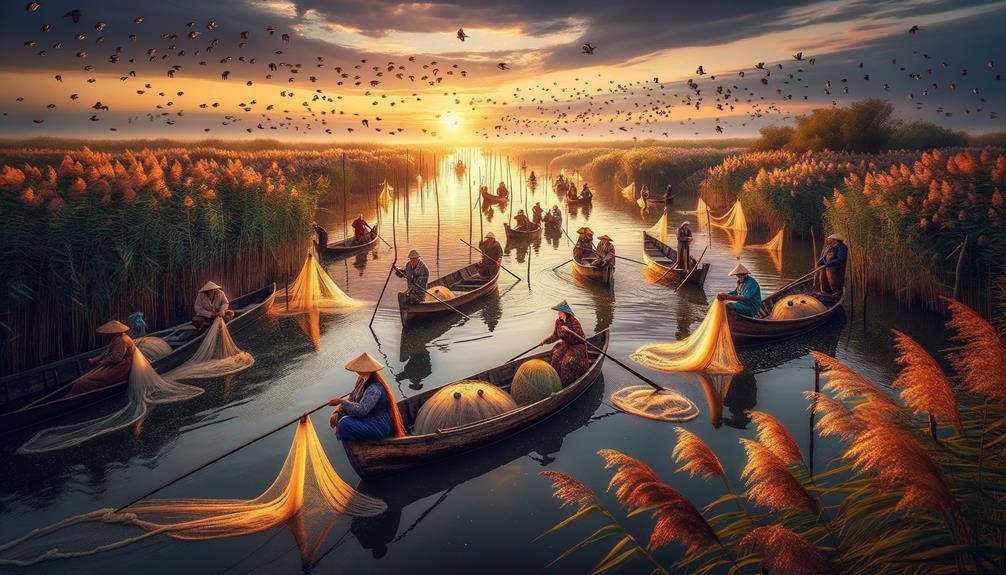
The Lipovan fishing communities in the Danube Delta have preserved their traditional techniques for centuries, living in harmony with the river's natural rhythms and ecology. These practices, handed down through generations, rely on an in-depth understanding of the delta ecosystem. As the Lipovan fishermen navigate the intricate waterways of the Danube River, they use wooden boats and hand-woven nets, tools that have stood the test of time.
Fishing isn't just a means of survival for the Lipovan communities; it's at the heart of their cultural identity. Their knowledge of the seasonal migration patterns of various fish species allows them to fish sustainably, minimizing their impact on the delta's ecological balance. This expertise is crucial, especially in a world where industrial fishing often has devastating effects on marine environments.
Conservation Efforts
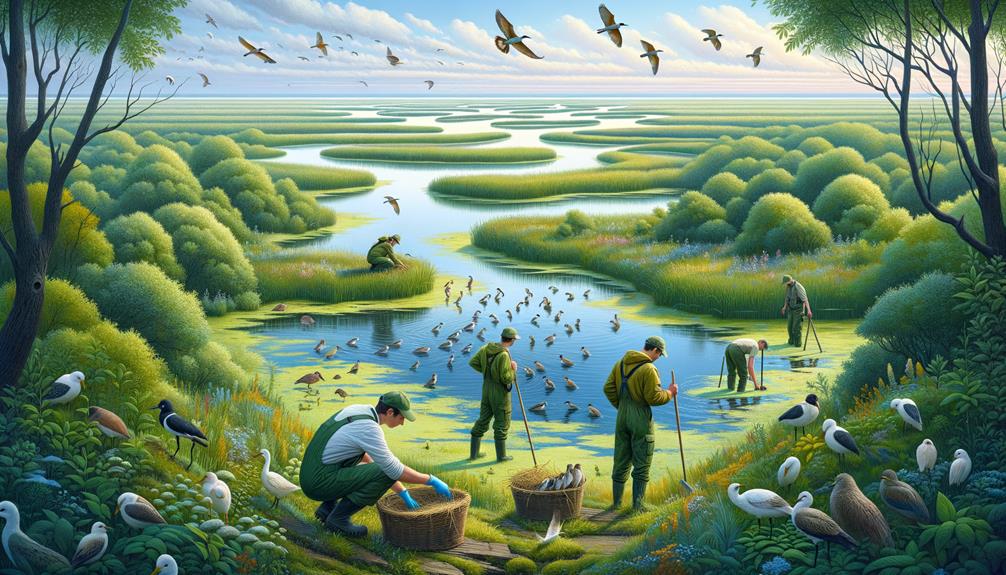
Conservation efforts in the Danube Delta have made significant strides by focusing on habitat restoration and cross-border collaboration. Reflooding former polders and lakes has reconnected waterways, revitalizing natural flooding and grazing processes crucial for the wetland's health. This UNESCO World Heritage Site is now thriving.
Romania and Ukraine are working together to manage this shared natural resource. By harmonizing conservation strategies, they're enhancing the delta's biodiversity. Key initiatives focus on recovering endangered species like Dalmatian pelicans, sturgeons, and white-tailed eagles through habitat restoration and threat reduction.
Sustainable development projects in the delta engage local communities, promoting nature-based tourism and the sustainable use of wild resources. These initiatives not only protect the wetland but also create new economic opportunities for residents. Ecotourism, for instance, raises awareness about the delta's ecological significance while generating income.
A balanced approach is key to effective conservation in the Danube Delta. Combining restoration, cross-border cooperation, and sustainable development ensures the long-term preservation of one of the world's most biodiverse wetlands.
Frequently Asked Questions
What Is Danube Delta Known For?
The Danube Delta is a hotspot for biodiversity, boasting an impressive array of over 300 bird species and numerous fish species. As a UNESCO World Heritage Site, it features unique wetlands, lakes, and forests that attract nature enthusiasts and birdwatchers alike.
What Is the Danube Delta Rewilding Area?
Imagine a thriving wetland ecosystem where nature flourishes. The Danube Delta Rewilding Area is a massive 40,000-hectare project that's restoring natural flooding and grazing patterns, boosting local wildlife populations, and supporting eco-friendly businesses. As Europe's largest natural wetland, it's a haven for diverse species.
What Are the Three Branches of the Danube at Delta?
The three branches of the Danube at the delta are Chilia, which forms the Romania-Ukraine border; Sulina, the primary navigable outlet; and Sf. Gheorghe, flowing through the Romanian part. Each branch plays a distinct role in the delta's ecosystem.
How Do the Wetland Areas of the Danube Affect the Water Supply?
The Danube's wetlands play a crucial role in shaping our water supply. These natural wonders absorb floods, replenish groundwater, and act as a filter to remove pollutants, ensuring a steady and high-quality water source. By stabilizing water levels and purifying the water, they provide a reliable supply for our needs.
Is the Danube Delta in Ukraine?
Part of the Danube Delta lies in Ukraine, specifically the Dunaiski Plavni, which includes the Kiliya branch. This unique region spans across both Romania and Ukraine, requiring cooperation from both countries to effectively conserve its natural resources.


